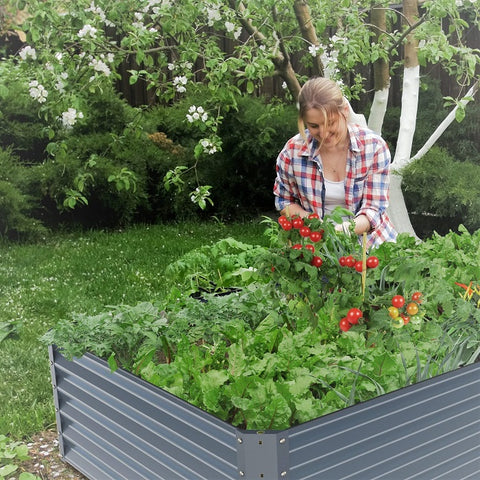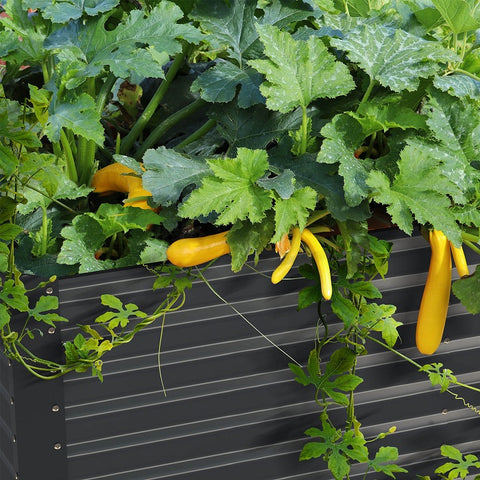You don't need a garden full of vegetables that no one wants to eat. Knowing what vegetables to grow in your garden will keep your family fed, healthy and happy. We gathered growing information on 5 easy-to-grow vegetables, their needs, and when to harvest them.The following content also has some reference value for raised garden beds.
- Lettuce
Lettuce is an annual or biennial leafy plant in the composite family whose leaves are used in salads. Lettuce varies in size, shape, and leaf type (depending on the variety), but in general, the plant's leaves will form dense heads or loose rosettes.
Uses - There are many ways to eat lettuce other than chopping it into a salad. Here are some of the options:
Juice or green smoothie, lettuce wrap, layered into spring rolls and rolls.
Sun requirements - Ideally, lettuce needs at least 6 hours of sun per day. However, if the energy received is less than this value, the lettuce will still grow.
Soil requirements - well-drained sandy loam with loose consistency and organic matter help this leafy vegetable to thrive.
Ideal soil pH: Soil with a pH of 6.0 to 6.5 is best for lettuce growth.
Expected harvest time - Leaf lettuce varieties can ripened in as little as 30 days, but they are ready to harvest when they are the size you want. Other lettuce varieties take 6 to 8 weeks to reach harvest size.
Step 2: Tomatoes
Tomatoes are a great addition to the home garden
Tomatoes are usually found to be red, scarlet or yellow. However, green and purple varieties can be grown, and their shapes range from spherical to oval, slender to pear-shaped. A single fruit contains at least two cells, or chambers, filled with tiny seeds immersed in a gelatinous, slightly acidic pulp.
Use - Tomatoes are widely loved for their versatility. Here are some ways to use fresh tomatoes: Italian tomato salad, gazpacho, bruschetta, sandwiches
Sun requirements - Healthy tomato growth and fruit production require 8 hours of direct sunlight per day.
Soil requirements - Tomatoes thrive in loam and sandy loam, but these plants can grow in almost all soil types except heavy clay.
Ideal soil pH - Tomato plants thrive in slightly acidic soil with a pH of 6.2 to 6.8.
Expected harvest time - Tomatoes are ready to be harvested within 60-85 days of planting seedlings in the garden.

Step 3: Chili
Bell peppers are a great addition to your home garden
Chili is a vegetable that comes in all shapes, sizes and colors. Pepper varieties can produce green, red, yellow, orange and even black fruit. Its taste varies between sweet and spicy.
Uses - Here are several uses for garden-grown peppers: bell pepper cornbread, roasted pepper and butternut squash soup, roasted red pepper soup
Sun requirement - Pepper plants need at least 6 to 8 hours of sun a day.
Soil requirements - Peppers like rich sandy or fertile soil, which keeps the soil well drained and warm.
Ideal soil pH: Peppers thrive in slightly acidic soil with a pH of 6.5 to 7.0.
Expected harvest time - Under ideal growing conditions, peppers are usually ready to be harvested in 70 to 80 days.
- Cucumber
Cucumbers are a great addition to the home garden. Cucumbers are annual plants with thick stems. Its hairy leaves have three to five pointed lobes and branched tendrils on the stem. Its five-petaled yellow flowers are unisexual, and the cucumber is a long, thin vegetable with a tough, green skin and moist, translucent flesh.
Uses - Here are a few uses for cucumbers grown in your garden: pickling, making frozen snacks
Sun requirements - Cucumbers thrive in full sunlight, but only need 5 hours of sun a day to grow.
Soil Requirements - Cucumbers grow best in loose, sandy loam soil. However, they can grow in almost any soil with good drainage.
Ideal soil pH - Cucumbers thrive in slightly acidic soil with a pH of 6.0 to 6.5.
Expected harvest time - This variety requires a long growing season, with most varieties harvested within 50 to 70 days of planting.

- Brussels sprouts
Brussels sprouts are a great addition to the home garden. Brussels sprouts are a variety of cabbage in the cruciferous family, grown for their edible small green leaf buds, similar to mini cabbages. The plant has long, smooth leaves that can be green to purple in color, alternating on the stem.
Uses - Brussels sprouts are often served as a side dish, here are some other ways to prepare them: Roasted Brussels sprouts with garlic, a holiday dinner side dish, roasted Brussels sprouts with butternut squash and cranberries
Sun needs - Brussels sprouts need at least 6 hours of sunlight a day to grow optimally.
Soil requirements - This vegetable can be grown in almost any well-drained, fertile soil.
Ideal soil pH - Brussels sprouts grow best in soil with a pH between 6 and 7.
Expected harvest time - Brussels sprouts are usually ready to be harvested 90 to 110 days after planting.
Garden vegetables
In this article, you discover several popular and easy to grow vegetables, what they need to maximize their growth, and when they should be harvested.
Growing your own vegetables can yield a great harvest, put food on the table that doesn't need store-bought vegetables, and taste better.
Not growing vegetables in your own garden leaves you dependent on the grocery store's supply chain, exposed to the potential chemical consumption of pesticides, and poor-quality vegetables.









